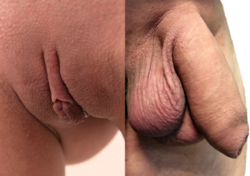Human reproductive system
This article needs additional citations for verification. (August 2021) |
| Human reproductive system | |
|---|---|
genitalia. | |
 Shaved external genitalia of an adult female (left) and male (right). | |
| Details | |
| Identifiers | |
| Latin | systemata genitalia |
| TA98 | A09.0.00.000 |
| TA2 | 3467 |
| FMA | 7160 75572, 7160 |
| Anatomical terminology] | |
The human reproductive system includes the male reproductive system which functions to produce and deposit sperm; and the female reproductive system which functions to produce egg cells, and to protect and nourish the fetus until birth. Humans have a high level of sexual differentiation. In addition to differences in nearly every reproductive organ, there are numerous differences in typical secondary sex characteristics.
Structure
Female

The human female reproductive system is a series of organs primarily located inside the body and around the pelvic region of a female that contribute towards the reproductive process. The human female reproductive system contains three main parts: the vulva, which leads to the vagina, the vaginal opening, to the uterus; the uterus, which holds the developing fetus; and the ovaries, which produce the female's ova. The breasts are involved during the parenting stage of reproduction, but in most classifications they are not considered to be part of the female reproductive system.
Approximately every 28 days, the pituitary gland releases a hormone that stimulates some of the ova to develop and grow. One ovum is released and it passes through the fallopian tube into the uterus. Hormones produced by the ovaries prepare the uterus to receive the ovum. The lining of the uterus, called the endometrium, and unfertilized ova are shed each cycle through the process of menstruation. If the ovum is fertilized by sperm, it attaches to the endometrium and the fetus develops.
Male

The male reproductive system is a series of organs located outside the body and around the pelvis region of a male that contribute towards the reproduction process. The primary direct function of the male reproductive system is to provide the male sperm for fertilization of the ovum.
Major secondary sexual characteristics include: larger, more muscular stature, deepened voice, facial and body hair, broad shoulders, and development of an Adam's apple. An important sexual hormone of males is androgen, and particularly testosterone.
The testes release a hormone that controls the development of sperm. This hormone is also responsible for the development of physical characteristics in men, such as facial hair and a deep voice.
Development
The
The Wolffian duct forms the
Reproduction
Production of gametes
Gametes are produced within the gonads through a process known as
In females, gametogenesis is known as oogenesis; this occurs in the ovarian follicles of the ovaries. This process does not produce mature ovum until puberty. In contrast with males, each of the original diploid germ cells or primary oocytes will form only one mature ovum, and three polar bodies which are not capable of fertilization. It has long been understood that in females, unlike males, all the primary oocytes ever found in a female will be created prior to birth, and that the final stages of ova production will then not resume until puberty.[4] However, recent scientific research has challenged that hypothesis.[5] This new research indicates that in at least some species of mammal, oocytes continue to be replenished in females well after birth.[6]
Disease
Like all complex organ systems, the human reproductive system is affected by many diseases. There are four main categories of reproductive diseases in humans. They are:

- Genetic or congenital abnormalities.
- Cancers.
- Infections, which are often sexually transmitted infections.
- Varicocele [7]
- Functional problems caused by autoimmune disorders, or other causes. The best-known functional problems include sexual dysfunction and infertility, which are both broad terms relating to many disorders with many causes.
Specific reproductive diseases are often
References
- ^ Sexual Reproduction in Humans. Archived 2018-02-17 at the Wayback Machine 2006. John W. Kimball. Kimball's Biology Pages, and online textbook.
- PMID 25905232, retrieved 2023-12-19
- ^ EDRI Federal Project Inventory: Cellular and Molecular Mechanisms of Abnormal Reproductive Development Archived 2008-12-06 at the Wayback Machine US EPA. Dr. William R. Kelce. 2006.
- ^ a b Development of sex cells Archived 2008-07-05 at the Wayback Machine in Reproductive system, Body Guide. Adam.
- PMID 18753611.
- S2CID 1124530.
- from the original on 2022-08-27. Retrieved 2022-08-27.
- ^ Genetic Conditions > Reproductive system. Archived 2008-12-04 at the Wayback Machine 2007. Genetics Home Reference. U.S. National Library of Medicine.
